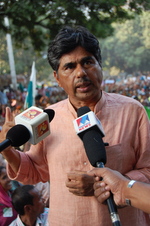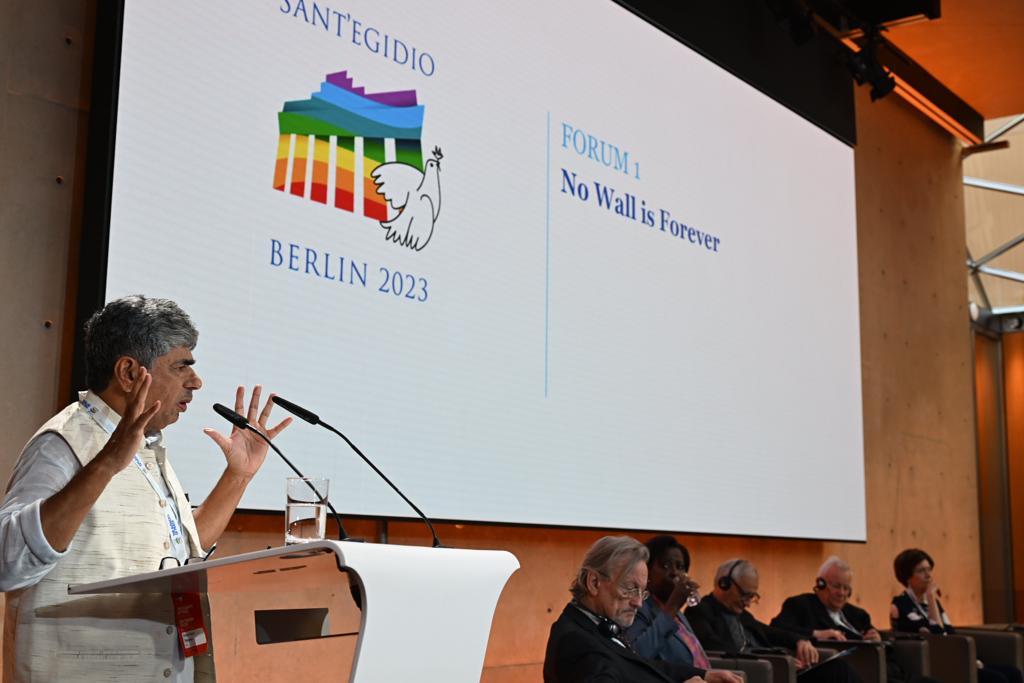
Puthan Veetil Rajagopal
Voorzitter en medeoprichter van Ekta Parishad, Niwano Vredesprijs 2023, Indiabiografie
Friends
First of all, I want to thank the organizers of this conference for inviting me to the conference and giving me an opportunity to speak. The theme suggested for my presentation “BREAKING WALLS”, I thought was very appropriate as this is an activity I am constantly engaged with in India.
Let me begin by saying that there are not many leaders today with a large global vision. The present-day leaders, whether in politics or in the economy, tend to build their positions around a set of interest to protect their own power base; and to do this, they create associative groups based on caste, class, religion, race and/or language. Such a narrow and partisan vision then, can be used to divide the society and create an "us and them" politics. In the process it can spark dislike and hate for " the other", and this gives the impression that if an associative group comes together, then they can deal with "the other group”.
In contrast, Mahatma Gandhi (during India’s Independence Movement) referred to a wider and inclusive vision called Sarvodaya (“Well-being of all”) and he explained the term as ‘my own well-being corresponds with the larger well-being of the society’ and not the other way round. He appealed to people to work for Sarvodaya using it as a guide at the national and local levels.
Mahatma Gandhi's associate Vinoba Bhave gave another equally important idea that was known as Jai Jagat ("One planet, One people"). He explained the need for human-kind to move beyond limited geographical landscapes, and accept the whole world as one planetary home. He viewed that contemporary problems of the world can’t be solved within a given geographical horizon but rather by strengthening global interconnections (with people and with nature).
The current challenge of the nuclear threat should compel us to move towards Sarvodaya, (“Well-being of all”) while the life-threatening climate crisis should have us embrace Jai Jagat, (“One planet One people”). Unfortunately, we continue with business as usual and follow the political muses of narrow nationalism or fortified regionalism. To put a brake on this current course will demand an enlightened political and economic leadership that facilitates a collective movement and incentivizes people to put planet above profit, and ‘sharing and caring’ above unbridled greed.
In considering some of the strategic approaches that can 'breakdown walls' wherever possible, I wanted to reflect on two moments in our collective history that profoundly changed the worldview of large populations. The first was the words of the two American astronauts, Neil Armstrong and Buzz Aldrin who landed on the moon in 1969, and when in orbit, took the iconic picture of the earth. For the first-time, this gave people across the globe a view of the planet from outside our earthly location. The astronauts remarked that there were no scratches on the face of our earth (meaning that there were no “walls” or boundaries dividing people into geographic regions). This photo symbolizes a planetary worldview that gives people a sense of a common future.
Another moment of inspiration of a common future was when Mahatma Gandhi conducted a nonviolent revolution against the British empire, not simply to liberate the country from an external imperial power, but to liberate people from oppression, exploitation and what we may call today, unsustainable peace. Gandhi pointed out that the walls were in the minds so if the behavior did not change, then the walls would not come down. Gandhi also provided numerous tools and methods for changing this mind-set. Once when the great historian Acharya Kripalani met Mahatma Gandhi, he asked how India's nonviolent revolution could succeed, when revolutions in France, Russia, or China had been violent......? Gandhi's quick response was: Mr. Professor; you are teaching history, but I am making history".
What later generations learned from Gandhi, in India, was how more advanced and civilized nonviolent methods can be invented to solve problems, if there is a desire to do so. By developing a commitment to use nonviolence, one can create tremendous transformational effect on people.
Let me cite an example. A global action, namely the Jai Jagat march, was initiated in 2019 by a social organization in India that was experienced in nonviolent social action. On the 2nd of October 2019 fifty peacebuilders from civil society in India and 12 other countries, planned to march from Gandhi’s samadhi (resting place) in New Delhi to the United Nations in Geneva, Switzerland over the course of one year. This yearlong march aimed at advocating for changes in the UN Sustainable Development Goals (SDGs) so that marginalized people’s perspective would be included. This long march of eleven thousand kilometers through 11 countries was challenging, as it required permission from different country governments and civil groups. Obtaining permission to walk through Pakistan, Afghanistan and Iran became a very demanding task because there were far too many walls to deal with. Finally, after completing our march within India, we were forced to send smaller delegations to Pakistan, Afghanistan and Iran, before regrouping in Armenia for the onward journey. Unfortunately, this long march had to be aborted after five-and-half months at Yerevan, the capital of Armenia due to the Covid pandemic. What the march achieved was it brought into focus the many walls that had been erected and also the strategic tools for bringing down these walls.
In the countries that the marchers traversed, walls had been created to protect the interests of the status quo and to prevent marginalized communities from taking their grievances to Geneva. Thousands of people who are denied justice in their own countries wanted to express their grievances at the global level by joining hands with the "Jai Jagat" long march and have their voices heard by the architects and implementors of the UN SDGs (Sustainable Development Goals).
The implementation of the UN SDGs has not adequately responded to people at the bottom of the socio-economic hierarchy and as a result many men and women from Northern Africa, and from Syria and Afghanistan are risking their lives in the perilous boat journey to Europe across the Mediterranean. It is unfortunate and shocking that instead of reaching out to people to release them from their pain and suffering, many governments are busy, strengthening the border security forces and creating fortified walls and barb-wire fences. To face such a situation in a so-called civilized world can’t be acceptable. If millions of people are suffering from poverty and deprivation and the state continues to suppress their voices in the name of national pride and internal security, this is a moral affront and a violation of Humanitarian Law. What is needed is not tighter security systems but delivery of justice that creates genuine human security.
For about 25 years now, I have been involved in mobilizing large number of marginalized indigenous people to challenge the unjust system that is displacing them from their land and livelihood resources. The processes of urbanization, privatization and mechanization have thrown many into cities and slums. I was using Gandhian nonviolent methods to mobilize the people to pressure the government to make policies that are in the interest of the poor and marginalized. For instance, thousands of people marched for 3,500 kilometers in 2000 for a period of six months; twenty-five thousand people marched for 350 kilometers in 2007 to the capital of India: a hundred thousand people marched in 2012. As a result of these organized nonviolent mass actions, it was possible to make some important policy changes, in the long run, through experience, we have learned the art and science of nonviolent mass mobilization as a way to bring down some of the walls that were built to maintain injustice and discrimination.
I hope this conference can make an effort with those occupying positions of power to work towards a system that can deliver justice to all, not only people but also to nature. It is also important that people continue to promote and strengthen nonviolent mass actions from the grassroots-level of the society, to have them press for change towards building a society based on justice and peace.
In conclusion, we hold out hope that some of the upcoming political leaders can have a broader worldview and be able to provide the inspiration of a Neil Armstrong or a Mahatma Gandhi and work on strategies to bring down walls, whether they are political, social or economic. A slogan we often use in India are: “injustice anywhere is injustice everywhere”, and "violence anywhere is violence everywhere'.
Jai Jagat
